
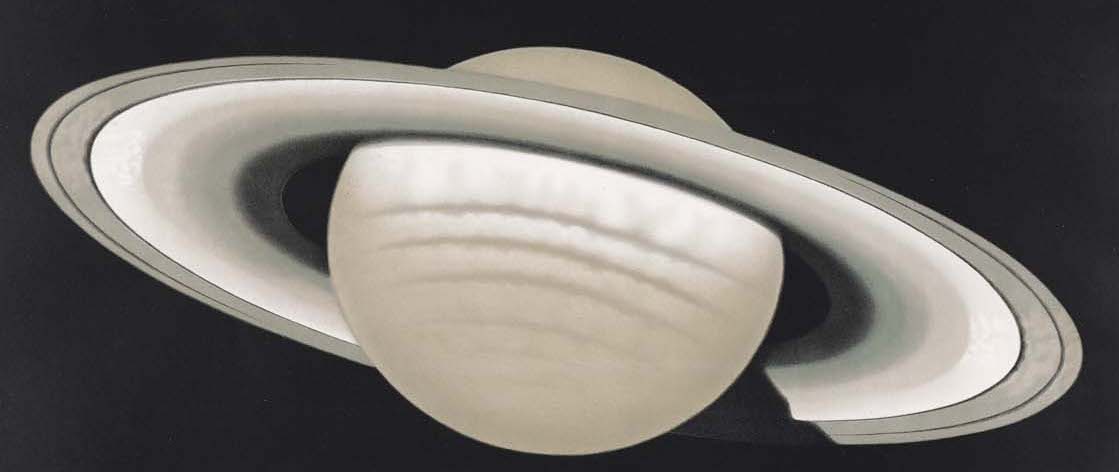
Maps and diagrams are effective in explaining the Cosmos. They were prominent in the public lectures on astronomy that were a popular form of entertainment in the early 1800s: lanterns projected images painted on glass onto screens. In reaction, Isaac Frost, a member of the Muggletonians, a small Protestant sect founded in London in the 1600s, wrote Two Systems of Astronomy (1846) both to disprove the heliocentric Cosmos (“Newtonian system”) and to explain the “Scriptural system” derived from a literal interpretation of the Bible. In this handsome volume, Frost mimicked the popular lantern slides with eleven color prints. Six are shown here [B3–B8].
Among other things, Muggletonians argued that Heaven is just six miles above the Earth, that the Sun and Moon are actually no bigger than they appear, and that they revolve around the Earth [B6, B8]. The Newtonian system was wrong to posit the existence of multiple solar systems [B3] because they would leave no physical place for God and humanity would no longer possess a privileged place in God’s Creation. Frost distorted scale greatly to make his diagrams work, a strategy used today by those who argue that the Earth is flat. For example, to judge from the Earth’s diameter (ca. 8,000 miles), Frost positioned both Sun and Moon about 1,750 miles above the Earth in plate 10 [B8], not the six miles maintained by the Muggletonians.
The pioneer color printer George Baxter produced these complex diagrams. The “key” plate for each image, to print the basic form and primary shading in black, was copper, either engraved or etched; further colors were then printed from relief blocks made from wood or zinc. The final prints are quite different from any other imagery Frost’s readers might have seen and would have made a powerful contribution to his argument.
Much astronomical imagery has been directed at popular audiences, both to educate and to persuade. Works of celestial art were relatively expensive and proclaimed their owners’ taste, wealth, and education. From this perspective, they had to be decorative, but not necessarily accurate or up-to-date. More popular astronomical works thus ranged from the “scientific” to the more strictly decorative.
Willem Jansz. Blaeu had studied with the great Danish astronomer Tycho Brahe, and he based his celestial globe of about 1598 on Brahe’s new star catalog. For the globe’s 1603 republication, displayed here, Blaeu added information obtained by the latest Dutch voyages to the southern hemisphere. He drew the constellation figures with their backs to the viewer, as they should appear: constellations looked down on the earth, from the celestial vault, so they would have their backs to viewers looking in from outside.

map/2319.0001
Willem Janszoon Blaeu, Sphaera Stellifera
(Amsterdam, 1603)
Hand-colored copper engraving, 34 cm diameter
Smith Collection
URL: www.oshermaps.org/map/2319
Market demands led many globemakers to draw the constellations on their celestial globes incorrectly, facing outwards, to show a more attractive figure to the viewer. This was the case with a globe made in London in about 1810 by Charles Smith, which was later copied by Josiah Loring in Boston in 1832. Item B2 is a later version published in 1854, largely unchanged from Smith’s original.
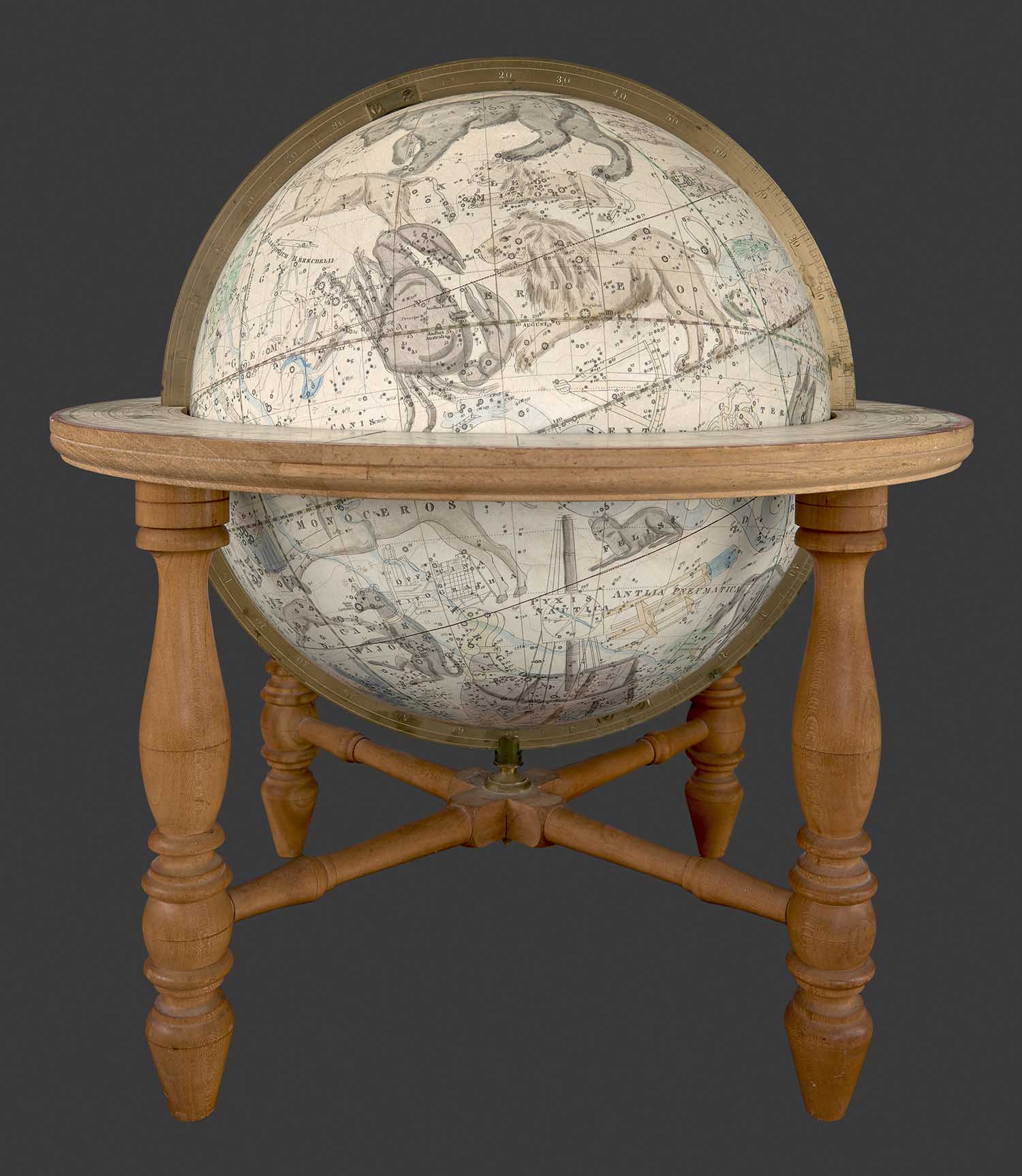
map/49627
Josiah Loring, Loring's Celestial Globe
(Boston, 1854)
Hand-colored copper engraving, 30.5 cm diameter
Smith Collection
URL: www.oshermaps.org/map/49627
“Plate 1 represents part of the great universe, according to the Newtonian system; the stars as suns, with worlds revolving round them, as is supposed.”
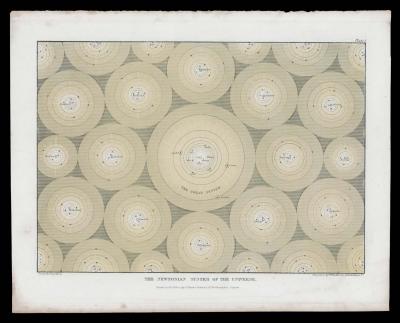
map/50187
Isaac Frost, The Newtonian System
From Two Systems of Astronomy (London: Catchpool & Trent and Simpkin, Marshall, & Co., 1846), plate 1
Color print from multiple surfaces, 19.5 x 27.5 cm
OML Collection
URL: www.oshermaps.org/map/50187
“Plate 3 shows the sun in the centre of the system: the Earth, Mars, and Jupiter, with their several distances from each other.—The Earth and Mars are put a little out of their proper place, for the purpose of explanation, in the same manner as Plate 2.”
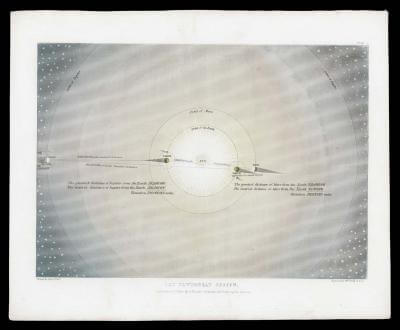
map/50192
Isaac Frost, The Newtonian System
From Two Systems of Astronomy (London: Catchpool & Trent and Simpkin, Marshall, & Co., 1846), plate 3
Color print from multiple surfaces, 19.5 x 27.5 cm
OML Collection
URL: www.oshermaps.org/map/50192
“Plate 6 is designed to show how it would be if the sun was a fixed body in the centre, and the earth revolving in its orbit round it—how the earth would vary with every fixed star on the equator, by degrees, throughout the whole of its orbit, and would not be in the same position with any one of those fixed stars two successive days throughout all the year, either in its diurnal or annual motion, but would be in one position with each star once in every year, and not oftener.”

map/50188
Isaac Frost, The Newtonian System
From Two Systems of Astronomy (London: Catchpool & Trent and Simpkin, Marshall, & Co., 1846), plate 6
Color print from multiple surfaces, 19.5 x 27.5 cm
OML Collection
URL: www.oshermaps.org/map/50188
“Plate 7 shows the earth in the centre, and the impossibility of the sun being more than about three diameters of our earth in distance from the earth, which would be about 24,000 miles, otherwise the sun would be seen in the distance far below the earth in the morning and in the evening, and we should see the sun for more than twelve hours on the equator out of the twenty-four hours; this will deduct from the Newtonian
computation of 95,000.008 of miles,
the following number 94,976,000
Remainder 24,000
and will also show that should the sun be at that distance, we should then only have six hours darkness out of the twenty-four, as may be seen by the shadow of the earth.—The poles in the plate are placed east and west, for the purpose of showing the globe more perfectly.”
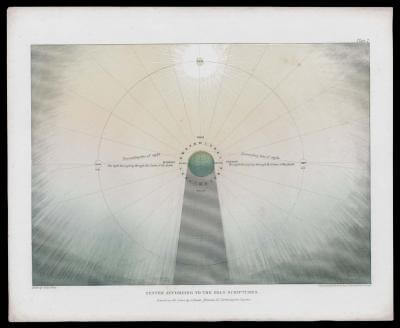
map/50189
Isaac Frost, System According to the Holy Scriptures
From Two Systems of Astronomy (London: Catchpool & Trent and Simpkin, Marshall, & Co., 1846), plate 9
Color print from multiple surfaces, 19.5 x 27.5 cm
OML Collection
URL: www.oshermaps.org/map/50189
“Plate 9 shows that the six divisions of that part of the earth situate between the two tropic lines of Cancer and Capricorn, are the spaces which Enoch, the seventh from Adam, calleth six gates, wherein the sun goes forth in the visible heavens to shine upon the earth, and the sun going twice through each gate, makes twelve times (or twelve months), one whole year: the year originally commenced when the sun was on the equator, and then it traversed six months in the northern hemisphere and six months in the southern hemisphere; the year was then completed.”
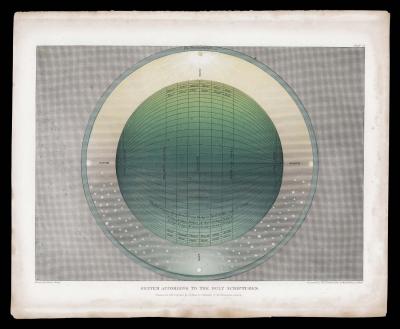
map/50190
Isaac Frost, System According to the Holy Scriptures
From Two Systems of Astronomy (London: Catchpool & Trent and Simpkin, Marshall, & Co., 1846), plate 7
Color print from multiple surfaces, 19.5 x 27.5 cm
OML Collection
URL: www.oshermaps.org/map/50190
“Plate 10 gives at one view the day and night scene of the sun, moon, and the stars shining upon the earth; and will at once strike the mind with the truth of those declarations of Moses, when he says in his declaration of the creation of the world (see Genesis), that ‘God made two great lights ; the greater light to rule the day, and the lesser light to rule the night: he made the stars also. And God set them in the firmament to shine upon the earth.’ About one-half of the stars are to be seen, the others being hid from view by the light of the sun: the clouds are omitted, to show the luminaries more clearly.”
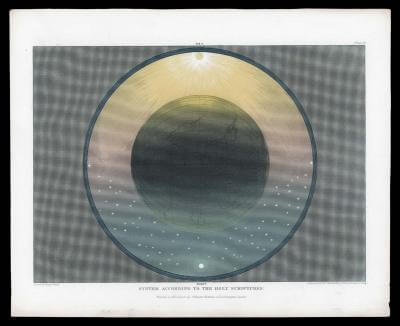
map/50191
Isaac Frost, System According to the Holy Scriptures
From Two Systems of Astronomy (London: Catchpool & Trent and Simpkin, Marshall, & Co., 1846), plate 10
Color print from multiple surfaces, 19.5 x 27.5 cm
OML Collection
URL: www.oshermaps.org/map/50191
Visualizing the Stars
Across ancient cultures, people sought to bring order to the chaos of the night sky by grouping stars within constellations. In the second century ce, Claudius Ptolemy cataloged 1,022 stars by 48 constellations, describing the place of each within the imagined figure.
In 1603, Johannes Bayer mapped each of Ptolemy’s 48 constellations in turn, listing the relevant stars on the back of each map. Bayer mapped the stars according to the coordinates listed in Tycho Brahe’s revised catalog (ca. 1598). He depicted the stars by their magnitude, or apparent brightness: the brighter the star, the larger its symbol. Bayer also ranked the stars within the constellation by their magnitude and gave each labels that later became standard and are still used today: a, alpha, the first letter of the Greek alphabet, for the brightest; then b, beta, the second letter, for the next brightest; and so on.
The two brightest stars in Orion were the 2nd and 35th in Ptolemy’s listing for the constellation, respectively described as being in Orion’s “upper left arm” (in humero sinistro) and “the extremity of the right food” (in extreme pede dextro). Arabic astronomers would later name these stars Betelgeuse and Rigel. In Bayer’s map of Orion, shown here, they are clearly distinguished as a and b orionis.

map/4453.0120
Johannes Bayer, Orion
From Uranometria (Augsburg: Christophorus Magnus, 1603), plate 35
Copper engraving, 27 x 37 cm
Smith Collection
URL: www.oshermaps.org/map/4453.0120
Visualizing the Solar System
When Galileo first turned a telescope to the night sky, in 1609, the planets ceased to be points of light wandering across the field of the fixed stars. They acquired dimensions and visual texture, and they began to hold astronomers’ attention. (Right: one of Galileo’s sketches of the Moon.)
The Moon was originally mapped in detail as providing a possible solution to determining longitude on Earth by timing the passage of the Earth’s shadow over the Moon’s surface during a lunar eclipse; observers would have to be to be able to refer to precise locations of lunar features. Johannes Hevelius compiled the first comprehensive map of the Moon from multiple observations and published it in 1647; in 1651 Giovanni Batista Riccioli applied a system of names drawn from terrestrial features. The combination of Hevelius’ and Riccioli’s work was repeated for the next 150 years, as here.
This Moon map is from Johann Gabriel Doppelmayr’s celestial atlas of 1742, a work intended not for scientists but the educated public. The atlas was an astronomical compendium with many pertinent decorations, such as the image of Diana, Roman goddess of the Moon, in the upper-right corner of B10. Other plates explained Copernicus’s heliocentric model of the solar system and Tycho Brahe’s compromise model (all the planets revolve around the Sun; the Sun and the Moon revolve around the Earth).
Doppelmayr devoted much of his atlas to comets, a subject of constant scientific interest. Brahe proved in the 1570s that comets were indeed celestial, not atmospheric. Isaac Newton’s analysis of the 1680 comet proved that comets had the same kinds of orbits as planets, if greatly exaggerated. Edmond Halley’s 1705 prediction that a particular comet would return in 1758 led to great public interest in the comets. Doppelmayr summarized the theory of comets in one complex diagram: left, how the 1680 comet was tracked; right, the many comet orbits that had been determined.

map/4275.0056c
Johann Gabriel Doppelmayr, Tabula Selenographica
From Atlas Novus Coelestis (Nuremburg: Homann Heirs, 1742), plate 11
Hand-colored copper engraving, 48.5 x 57 cm
Smith Collection
URL: www.oshermaps.org/map/4275.0056c
The Changing Role of Constellations
As southern voyages and telescopic observations steadily increased the number of recorded stars, astronomers had to increase the number of constellations by which to organize them. In 1603, before telescopes, Bayer had organized 1,022 stars in the 48 constellations defined by Ptolemy in the second century (see B9). In 1801, Johann Elert Bode used 99 constellations to organize 17,240 stars in 99 constellations.
Yet even as constellations increased in number, their function was changing. Improvements in both catalogs and telescopes meant that by 1800 it was possible for astronomers to point their telescopes directly at stars, guided by their celestial coordinates, and not have to search for them via the constellation. To the astronomer, constellations were increasingly just portions of the night sky, no longer people- or animal-shaped guides.
Christoph Friedrich Goldbach recognized this changing status when he mde his remarkable celestial atlas. Each opening of the book presented two images of the same portion of the night sky. On the left is the sky itself, just the stars as they are seen from the earth. On the right is the sky with the astronomers’ reference systems (both with respect to the ecliptic [dashed] and the celestial equator [solid]), coordinates indicated in the margins, and also faint outlines of the constellations.
Goldbach printed his naturalistic star charts from copper plates, just like Bayer (B9) and Doppelmayr (B10), but used the technique of mezzotint to produce the dark night sky and the subtle depiction of nebulae.

map/4406.0040
Christoph Friedrich Goldbach, Quandrant, Bootes, Jagdhunde, Haupthaar der Berenice
From Neuester Himmels-Atlas zum Gebrauche fur Schul- und Akademischen Unterricht (Weimar: Verlag des Industrie-Comptoirs, 1799), plate 7
Copper-plate mezzotint
Smith Collection
URL: www.oshermaps.org/map/4406.0040
The educator Levy Yaggy included this complex diagram of the heavens as the first plate of his large portfolio of maps and models designed as a teaching aid in grade schools. The accompanying teacher’s handbook, by one Henry Rassweiler, emphasized that the work was intended to demonstrate the nature of the Earth before they actually started reading textbooks in geography.
The students would first see the image in the above facsimile. A map of the stars from the North celestial pole to about 45° South, and of the areas covered by each constellation, serves as a backdrop for a diagram of the solar system, centered on the Sun (placed in the impossible position of the celestial North pole). The teacher’s handbook barely mentions the stars, using them only as a backdrop to identifying the planets and their order. The planetary orbits (white circles) are not constructed to scale; e.g., the distance from the Sun to Jupiter is about five times the distance to the Earth, not two times as shown. Around this convoluted map are four pictures of celestial phenomena copied from Trouvelot’s drawings, published just five years earlier.
Lifting the flaps (at right) reveals a number of other diagrams, some moving, that showed different elements of the Earth within the Cosmos. Of particular note, in the upper-right corner, is the image of the “Moon as seen through the largest telescope / photo reproduction.” The suggestion is that this is a photograph of a telescopic view of the Moon. However, turning the U.S. Naval Observatory’s 26-inch telescope—then the largest—on the Moon would reveal a precise close up, such as Trouvelot’s image of the Mare Humorum (A9). This Moon map, like all others has been compiled from many detailed views and then reproduced photographically!

map/13719
Levi W. Yaggy, Planetary System
From Yaggy's Geographical Study (Chicago: Western Publishing House, 1887), first folio
Chromolithograph, 58 x 89 cm
OML Collection
URL: www.oshermaps.org/map/13719
The 1960s brought public attention to the far side of the Moon, as Soviet and US space missions began to photograph parts of the Moon never before seen from Earth. NASA’s Apollo program (1961–72) sent several manned missions around the Moon before Apollo 11’s successful landing (and return) in 1969. The new information was compiled into comprehensive maps by astronomers at Lowell Observatory and by the USAF Aeronautical Chart and Information Center. The results were published as a large globe, displayed here, which also marks the sites of landings by the first unmanned mission (Ranger 4, April 1962) and Apollo 11 (July 1969 in the Sea of Tranquility).
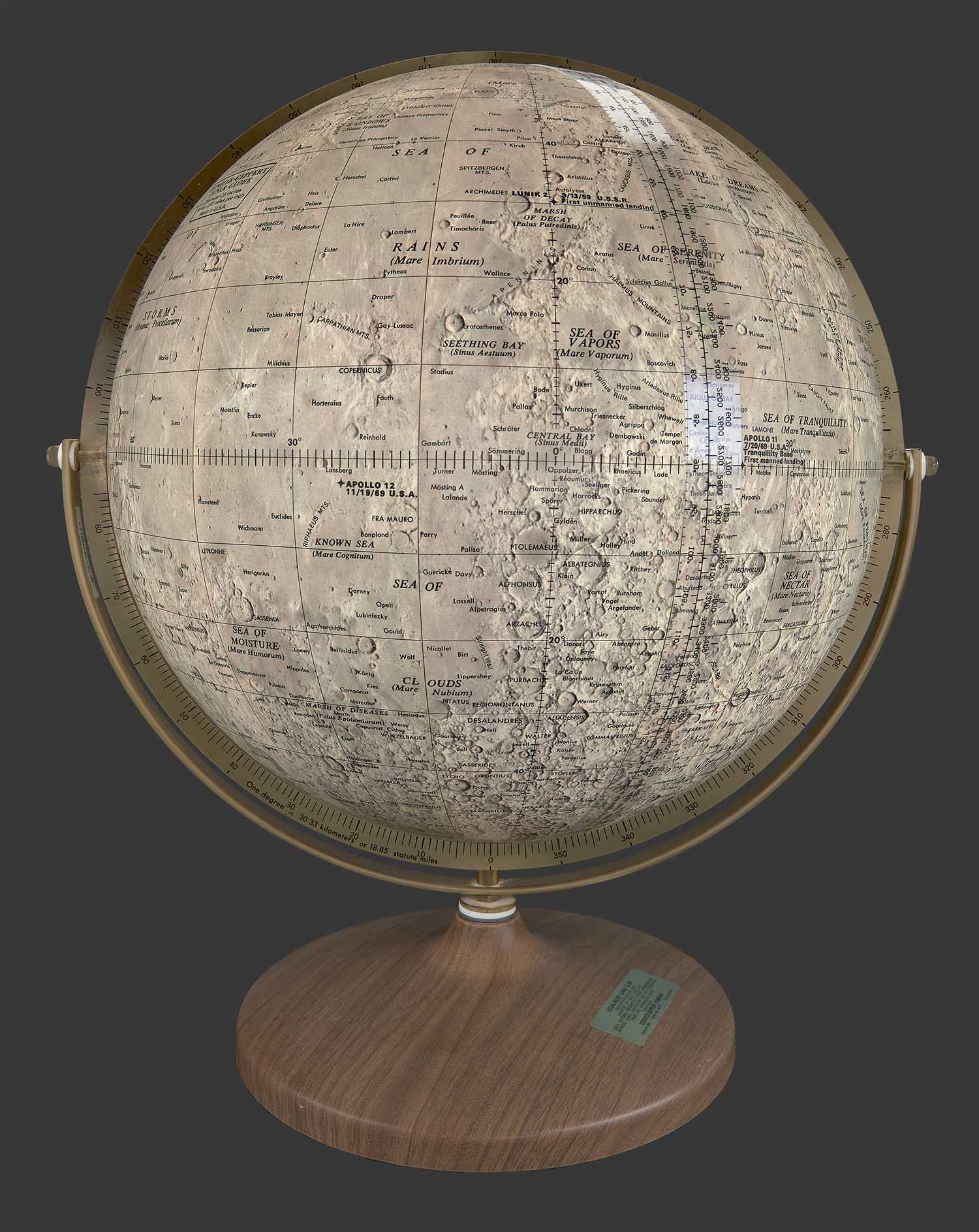
map/2361
Visual Relief Lunar Globe, (Chicago: Denoyer-Geppert, 1969)
Color-printed plastic, 40.5 cm diameter
Smith Collection
URL: www.oshermaps.org/map/2361
The curious artwork on the case floor demonstrates how the constellation was a largely irrelevant concept by 1900. Astronomers used constellation names, but to refer to regular portions of the Heavens; for everyone else, they were artistic symbols from ancient mythology.
The globe depicts and names the constellations in an art nouveau style (common, 1895–1914), reducing them to ornament. It misplaces the stars, so that Orion (at right) lacks his belt of three stars. In copying the name Ursa mayor from a source, the artist mistook the long-s ('∫') for 'f,' so the name appears as urfa mayor.

map/2355
[Untitled celestial globe], (ca.1900)
Steel, with gilt figures, 30.5 cm
Smith Collection
URL: www.oshermaps.org/map/2355